A properly chosen roof covering is not only about the beauty and representativeness of the building. This design directly affects the protection against moisture and temperature extremes, the cost of the object and its service life. Laying soft tiles is a technology that allows inexpensive but practical implementation of the most complex ideas in the field of roof design and efficiency. Knowing the subtleties and rules of carrying out this work, you can perform it even alone, having achieved an excellent result in all respects.
Features of installation of tiles
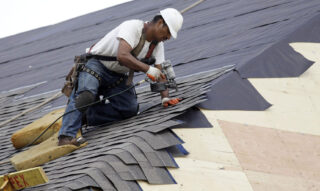
Self-assembly of shingles is not particularly difficult and does not require professional education. It is enough to understand the essence of the process and follow the manufacturer's instructions.
Bituminous roofing is a prefabricated roof consisting of many small waterproof fragments (shingles), laid on a solid and dense base. The arrangement of the plates is made overlapping, bonding to an adhesive base, duplicated with nails.
Laying shingles is the most popular method of covering residential and utility buildings in private construction.
This is justified by the following advantages of finishing:
- complete tightness;
- resistance to mechanical stress;
- the ability to design curved surfaces of any complexity;
- light weight;
- lack of wet works;
- simplicity and high speed of installation;
- long service life;
- presentable appearance.
Shingles can only be laid on a rigid base with minimal gaps between the slabs. Over time, the plates fuse together, which makes repairing the finish very difficult and sometimes impossible.
Climatic conditions for installation
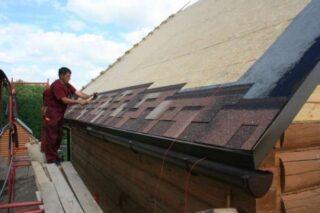
Installation of soft tiles can be carried out in almost all climatic zones of Russia. The cladding withstands extremely high heat and severe frosts equally well. The operating temperature range varies within ± 50 ° C. With a stronger cold snap, cracks may appear, and when heated, the fluidity of bitumen is possible.
Installation of tiles is allowed at a positive temperature, no wind and precipitation. It is necessary to wait until the material and the base are completely dry from dew, but do not allow them to overheat to prevent the tiles from melting in the package.
Roofing cake for soft tiles
The installation of the shingles is the final stage of the roof construction process, most of which is the preparation of the base for laying the roofing cake. It is a structure consisting of several interconnected layers, designed to ensure the correct functioning of the attic space. The technological level ensures proper ventilation, condensate drainage, proper heat exchange in the space under the roof. Roof tiles are a topcoat that performs an aesthetic and waterproofing function in a complex multi-layer coating system.
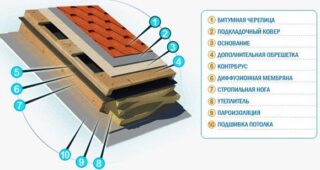
The roofing cake has the following device:
- Rafters. Spatial construction of timber and planks, serving as a frame and support for the constituent parts of the roof.
- Waterproofing.A layer that prevents moisture from penetrating from the attic space to the higher levels.
- Counter battens. Consists of planks horizontally stuffed onto the rafters. It is needed to ensure air circulation between the supports and the technological layer. Maintains an optimal moisture level for the roofing cake and base.
- Lathing. Another row of slats fixed to the counter batten. It is a support for installing the flooring, which is mandatory for fixing soft tiles.
- Flooring. Made from grooved boards, plywood or particle board. The thickness is matched to the support system. The weaker it is, the thinner the flooring is.
- Lining carpet. Designed to level the surface of the flooring and carry out its waterproofing. Mastics, tar and similar materials are used.
- Thermal insulation. Located between the rafters on the inside of the roof. Depending on the type of building, polystyrene, expanded clay, polyurethane foam or mineral wool can be used.
- Membrane film. Provides moisture transmission from the inside to the outside, prevents condensation and dampness in the attic.
- Interior decoration. Plywood, lining, drywall or imitation timber are selected.
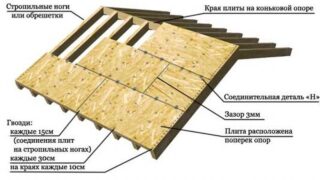
For lathing and counter-lathing, you should take boards from coniferous wood with a thickness of 30 mm or more. Such a gap is needed to ensure normal air circulation under the roof. Before installation, the rails must be treated with an antiseptic and a hydrophobic agent to protect against parasites and dampness. It is advisable to use a fire retardant that blocks fire for up to 30 minutes. The length of the boards is arbitrary, but they can only be joined on the beam below.
Laying shingles is allowed only on a continuous flooring. Since the fastening is carried out on nails, the appropriate material is selected. During installation, a gap is left between the fragments to ensure thermal and moisture expansion. For slabs it is 5 mm, and for boards 2-3 mm. The choice of the thickness of the material for the flooring depends on the pitch of the lathing. The larger the step, the thicker the flooring is required. The best option is a frequent step and thin slabs. In this case, a light but rigid base is obtained. It should be borne in mind that the frame should withstand the weight of the master without problems.
To exclude bending of the slats when the humidity changes, they must be nailed along the entire length in two rows with an interval of 50 cm.
The main stages of installation of shingles roofing

You should start with the arrangement of the workplace. It is necessary to perform the following activities:
- Take measurements. Recheck them, draw up a layout diagram for each element.
- Calculate the need for materials, see what tools are needed, what is in the arsenal, and what needs to be purchased.
- Equip a place for storing boards, boards, tiles and other property that will be used in construction.
- Carry out a purchase. Wait for a suitable time for work in relation to the weather.
In conclusion, it is necessary to fence off the building with a signal tape, if necessary, put up warning signs or a fence.
To cover a house with soft tiles, you need tools:
- hacksaw;
- hammer or cordless automatic pistol;
- level;
- roulette;
- scissors;
- iron ruler;
- paint brush;
- stationery knife.
List of materials:
- shingles in the right amount;
- mastic;
- nails;
- antiseptic;
- slats;
- membrane;
- cord;
- insulation;
- waterproofing.
To ensure your own safety, you will need insurance, a construction helmet, goggles and gloves.
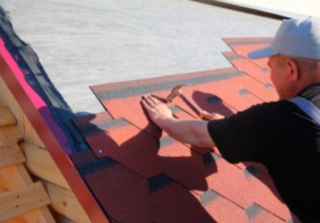
It is not difficult to calculate the required number of shingles: you need to take one fragment, measure the visible area, find out the area of the slope and divide the second by the first. As for nails, you need to take products with a smooth core, 35-45 mm long and a head diameter of 8 mm.It is better to overpay, but take galvanized nails than ordinary nails, which will rot from rust in a few years.
After installing the flooring, it is the turn of the lining carpet arrangement. The need for it is due to the likelihood of leaks through the shingles or at the junction. Consideration should be given to strong gusts of wind, which can tear off the roof covering and icing when the slabs rip off the tiles.
You can fix the substrate in the following ways:
- Kleev. Here, materials with an already applied adhesive layer are used, or it is done independently. The joints are coated with mastic and closed with aluminum tape.
- Mechanical. Densely rolled out over the area of the flooring, removed from its edges by 10-15 cm, and then nailed. Covering with this method is cheaper, but its reliability is lower.
For the manufacture of the substrate, it is recommended to use not roofing material or cellophane, but specially designed material with increased strength and long service life.
The installation of planks is a mandatory event for arranging the roof. They press the underlay carpet against the substrate, preventing it from being lifted up by the wind and moisture ingress. Metal, plastic or wooden slats must be laid on the edges of the covering and fixed with nails at 150 mm intervals in a checkerboard pattern. The products must be pretreated with anti-corrosion agents.
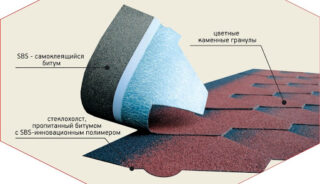
Installation of flexible roofing is carried out in the following sequence:
- Installation of the starting strip. You can do it yourself by cutting the petals, but it is better to take a ready-made roll. Such strips are produced by many well-known manufacturers. They can only be attached to nails, but it is better to duplicate the connection with mastic. The longer and steeper the slope, the more there should be an indent from the point of inflection.
- Marking. It is done with chalk and cord. Landmarks will make work easier and prevent errors that are extremely difficult to eliminate.
- Laying a vertical row in the middle of the ramp. This technique will ensure the evenness of the placement of subsequent horizontal rows.
- Nailing down the first level. Fixation is carried out according to the scheme so that the shaped holes of the adjacent petals coincide. The force should be so calibrated that the shingles are pressed against the base without gaps, but also without immersing the caps into the coating.
- Adjacent to the wall. The edges of the trim are wound on vertical surfaces and glued with mastic. An end strip is screwed on top of the tile, the L-shaped upper edge of which is recessed into a previously made groove. The joint is sealed with a sealant.
- Installation of a ridge and ventilation. The tiles are displayed under the upper cuts of the slopes and there they are trimmed horizontally. Spinal scales are bent in the middle, after which they are attached in the same way along the ridge part. Fixation is carried out with nails with an increased volume of mastic.
In conclusion, additional parts are installed - aerators, snow retainers, gutters, end and cornice strips.
The main mistakes when installing shingles
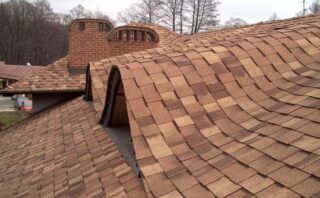
The most common mistakes made by inexperienced developers:
- the use of raw boards when installing the ramp;
- ignoring the arrangement of continuous flooring;
- the use of cheap materials in the manufacture of the substrate;
- nailing shingles with ordinary nails;
- saving on devices - working with a hammer is more difficult, longer and more dangerous than with an automatic tool;
- installation at low temperatures, when the tile may crack;
- neglect of safety precautions, which leads to injury.
When cleaning the slopes, do not use solvents and sharp objects, so as not to damage the shingles.








